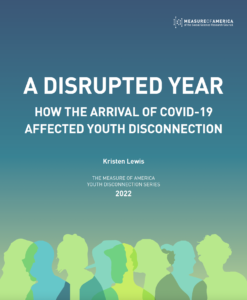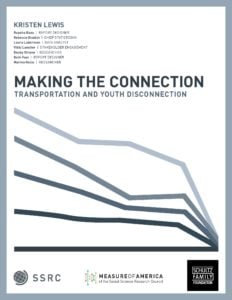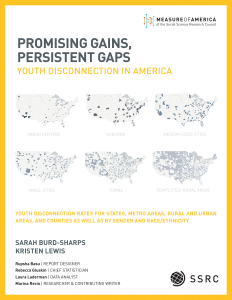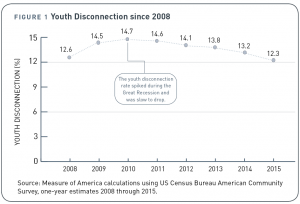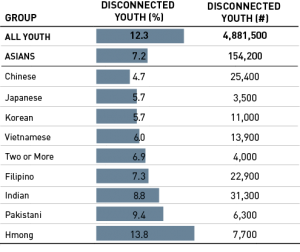A Disrupted Year: How the Arrival of Covid-19 Affected Youth Disconnection
To see the most recent data, check out our interactive tool on youth disconnection.
LAUNCHED MARCH 31, 2022
FULL REPORT | INTERACTIVE TOOL | MEDIA RELEASE| LAUNCH WEBINAR
On the eve of the Covid-19 pandemic, the number of teens and young adults disconnected from both work and school in the United States was lower than it had been in over a decade. Between 2010 and 2019, the youth disconnection rate fell 27 percent, driven largely by the steady increase in youth employment in the years following the Great Recession. The 2020 national youth disconnection rate is 12.6 percent, or 4,830,700 disconnected youth—an upward spike that reverses a decade-long trend of falling rates. The rate increase signals a Covid-fueled reversal of the decade-long decline in the share of the country’s young people neither working nor in school. In addition, due to Covid-related data challenges, the report argues that this rate is likely an underestimate of the true extent of disconnection in the first year of the pandemic; in other words, the youth disconnection rate for 2020 is at least this high and very likely higher.
A Disrupted Year: How the Arrival of Covid-19 Affected Youth Disconnection is the latest in Measure of America’s series of annual reports on teens and young adults ages 16–24 years who are neither working nor in school, a group referred to as disconnected youth or opportunity youth. The youth disconnection rate is a vital metric of access to opportunity and societal well-being. People acquire skills, credentials, habits, and experiences fundamental to a rewarding, productive, and joyous life during their teens and early twenties. The youth disconnection rate thus tells us which young people in our society have the chance to lay the groundwork for freely chosen, flourishing lives and which groups face serious challenges in the transition to adulthood. Research shows that being disconnected as a young person has long-term consequences; it’s associated with lower earnings, less education, worse health, and even less happiness in later adulthood. Determining who remains disconnected, and why, is vital to identifying strategies and interventions, especially in the wake of the Covid-19 pandemic.
The Covid-19 pandemic continues to pose countless health, educational, and economic challenges. The events of 2020 deprived America’s young people of a host of experiences that would have allowed them to build the capabilities required to live flourishing lives as adults. In addition, the burden of the Covid-19 pandemic has fallen disproportionately on low-income communities of color, which are also disproportionately home to the highest rates of youth disconnection.
A Disrupted Year presents 2020 youth disconnection rates for the United States as a whole as well as by gender, race and ethnicity, region, state, metro area, and congressional district. The report also offers recommendations on how to better serve out-of-school and out-of-work young people.
KEY FINDINGS
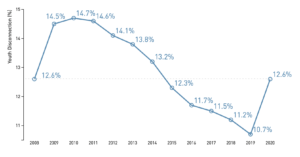 National rate: The 2020 youth disconnection rate is 12.6 percent, or 4,830,700 young people.
National rate: The 2020 youth disconnection rate is 12.6 percent, or 4,830,700 young people.- Data challenges: The onset of the Covid-19 pandemic severely disrupted the federal statistical collection and curation processes. These disruptions resulted in lower American Community Survey response rates not only from the very groups most likely to be out of school and work, such as low-income, Black, and Latino households, but also during the initial months of the pandemic, when the economy shed literally millions of jobs. Although the Census Bureau took several steps to shore up the 2020 survey data by cross-referencing additional government data sources, the Bureau nonetheless released these data with a host of caveats and urged users to exercise caution when making comparisons to previous years’ data. These caveats suggest that the estimates we provide in this report understate the magnitude of youth disconnection in 2020; we believe that the actual rates, in other words, are at least this high and likely higher. That said, these data are still the most comprehensive and reliable available.
- Gender: As in past years, girls and young women are less likely to be disconnected than boys and young men, 12.1 percent versus 13.2 percent. The size of the gender gap varies by race and ethnicity, however.
- Race and ethnicity: Nearly one in four Native American teens and young adults are neither working nor in school. The Native American youth disconnection rate is 23.4 percent, the highest of the United States’ five major racial and ethnic groups. Black teens and young adults have the second-highest disconnection rate, 19.6 percent, or 982,900 young people. Black young people have the largest gender gap in the youth disconnection rate of any racial or ethnic group—16.6 percent for Black girls and young women, compared to 22.5 percent for their male counterparts. The Latino youth disconnection rate stands at 14.0 percent, or 1,258,700 young people. In past years, Latina girls and young women were slightly more likely than their male counterparts to be disconnected, but in 2020, the male and female rates were the same, 14.0 percent. The disconnection rate for white teens and young adults is 10.6 percent, the second-lowest rate. White teens and young adults make up the largest absolute number of disconnected youth, 2,087,800 people. Asian teens and young adults have the lowest disconnection rate, 7.3 percent, or 156,100 young people. Rates vary widely by Asian subgroup and gender, however, from a low of 4.5 percent for Chinese and Japanese boys and young men to a high of 18.8 percent for Cambodian boys and young men.
- Regions: The West South Central region, which comprises Arkansas, Louisiana, Oklahoma, and Texas, has the highest disconnection rate of any region in the United States, 14.6 percent. The West North Central region has the lowest disconnection rate of all US regions, 9.9 percent; it is home to seven states: Iowa, Kansas, Minnesota, Missouri, Nebraska, North Dakota, and South Dakota.
- States: Nebraska has the lowest youth disconnection rate (7.8 percent), followed by New Hampshire (8.3 percent) and Minnesota (8.6 percent). New Mexico has the highest rate (19.6 percent), followed by Alaska (19.5 percent) and Arkansas (17.4 percent).
- Metro areas: Provo-Orem, UT (6.9 percent), boasts the lowest youth disconnection rate of the 100 most populous metro areas in the country, followed by San Jose-Sunnyvale-Santa Clara, CA (7.0 percent), and Madison, WI (8.2 percent). Although Madison has one of the lowest rates overall, the rate for Black young people in that metro area is very high, 21.2 percent. The highest youth disconnection rate can be found in Albuquerque, NM (19.7 percent), followed by Bakersfield, CA (19.6 percent), and McAllen-Edinburg-Mission, TX (18.8 percent).
- Congressional districts: California’s 52nd congressional district, which includes the bulk of the city of San Diego, has the lowest youth disconnection rate (5.3 percent). Michigan’s 14th congressional district, which includes some of the lowest-income neighborhoods in Detroit, is home to the highest youth disconnection rate, 25.0 percent.
For media and all other inquiries, contact us at: contact@measureofamerica.org
A Decade Undone: 2021 Update
To see the most recent data, check out our interactive tool on youth disconnection.
LAUNCHED JULY 29, 2021
FULL REPORT | INTERACTIVE TOOL | MEDIA RELEASE
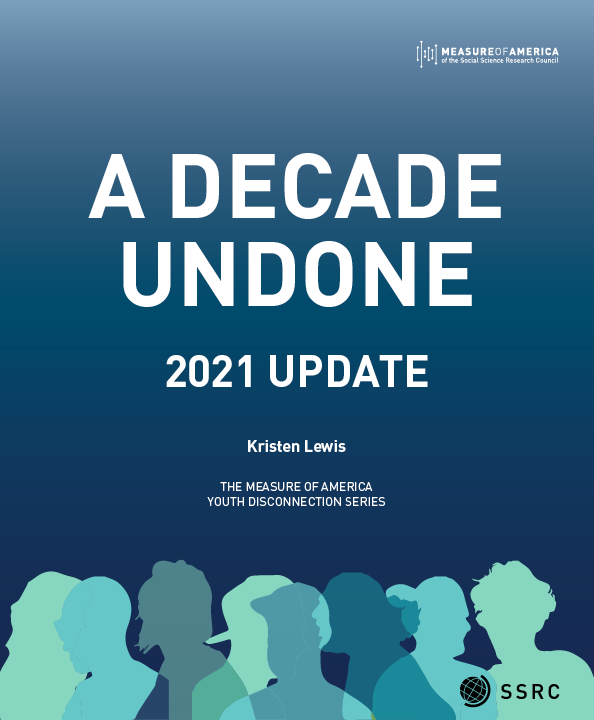 A Decade Undone: 2021 Update, a follow-up to last year’s A Decade Undone: Youth Disconnection in the Age of Coronavirus, presents 2019 youth disconnection rates for the United States as a whole as well as by gender, race and ethnicity, region, state, metro area, county, congressional district, and public use microdata area (PUMA). These pre-coronavirus numbers create a map of vulnerability; they highlight where disconnection rates were already highest and therefore where the situation today is most precarious.
A Decade Undone: 2021 Update, a follow-up to last year’s A Decade Undone: Youth Disconnection in the Age of Coronavirus, presents 2019 youth disconnection rates for the United States as a whole as well as by gender, race and ethnicity, region, state, metro area, county, congressional district, and public use microdata area (PUMA). These pre-coronavirus numbers create a map of vulnerability; they highlight where disconnection rates were already highest and therefore where the situation today is most precarious.
The number of teens and young adults disconnected from both work and school in the United States fell for the ninth year in a row, from a recession-fueled high of 14.7 percent in 2010 to 10.7 percent in 2019. The Covid-19 pandemic has caused youth disconnection rates to spike dramatically. We estimate, based on currently available youth unemployment data from the Bureau for Labor Statistics, enrollment and employment data from the Census Current Population Survey, and school closure information, that in May 2020 as many as nine million young people were out of school and out of work, more than twice as many as in 2019. Given the decline in youth unemployment in the second half of 2020, we anticipate that the number for 2020 as a whole will be closer to six million—considerably higher than in the years after the Great Recession. With students physically disconnected from schools and unemployment the highest it’s been since the Great Depression, young people with the fewest resources will be left even further behind their peers and face the highest barriers to reconnection. While it is clear that young people of all stripes will suffer, low-income people of color will be the hardest hit.
In the conclusion to this report, Measure of America identifies thirty “post-pandemic priority counties” where the combination of already-high youth disconnection rates (24 percent and up) and lengthy stretches of virtual-learning education during the 2020–2021 academic year has created an educational emergency. In these counties with high rates of disconnection and school closures, already- and newly-disconnected youth urgently need assistance to close preexisting educational gaps, regain the ground they lost in 2020, reconnect to the education system, and receive the help they need to gain a foothold in the labor market.
KEY FINDINGS
- Nationally: The 2019 youth disconnection rate is 10.7 percent, or one in nine young people, down from 11.2 percent in 2018. The country’s disconnected youth are nearly twice as likely to live in poverty, more than three times as likely to have a disability, more than twice as likely to lack health insurance, and more than twenty times more likely to be institutionalized compared to connected youth. Disconnected youth 21-24 years old are less than half as likely to have a bachelor’s degree as their connected counterparts. Disconnected young women are over four times as likely to be mothers as their connected peers.
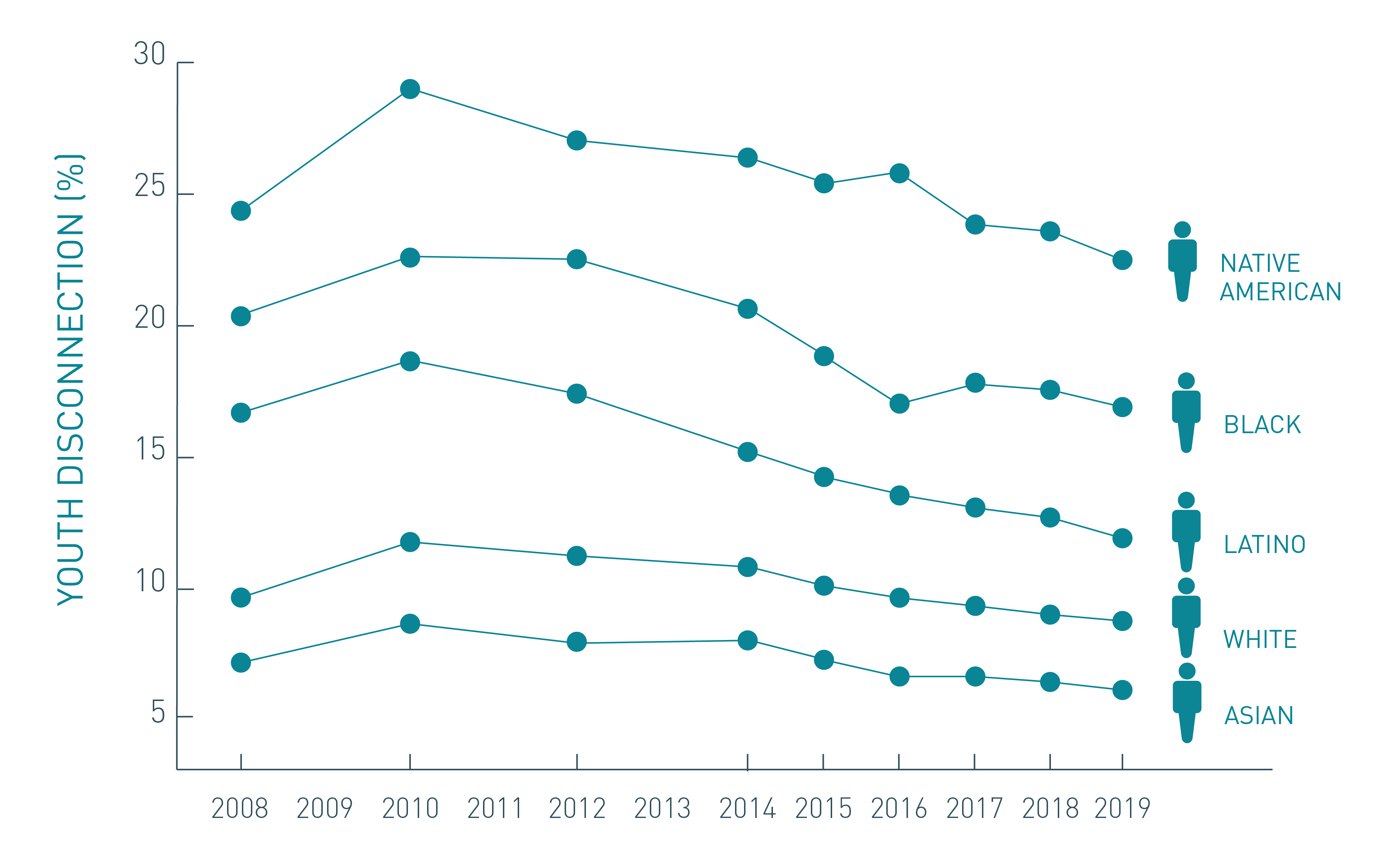
- Race and ethnicity: Native American youth had the highest disconnection rate (22.1 percent) of any major racial or ethnic group, followed by Black (16.7 percent), Latino (12.1 percent), white (8.8 percent), and Asian (5.7 percent) young people. Across all these groups, youth disconnection fell from 2018 to 2019.
- Gender: Women had a lower youth disconnection rate (10.3 percent) than men (11.0 percent); however, this gap varied by race and ethnicity. The largest racial gender gap existed between Black young women (13.7 percent) and Black young men (19.5 percent). Native American men’s youth disconnection rate of 23.3 percent was the highest for any race/gender combination.
- Public use microdata areas (PUMAs): PUMAs are areas defined by the US Census Bureau; they have populations of at least 100,000 people. To create these geographies, urban counties are split into many PUMAs (Los Angeles has 69, for example) and sparsely populated rural counties are joined together. The result is places with similarly-sized population groups that allow for apples-to-apples comparisons. The ten best-performing PUMAs can all be found in affluent sections of large cities or in well-to-do suburbs of major metro areas, and all have youth disconnection rates below 3 percent. The ten PUMAs facing the greatest challenges have youth disconnection rates that range from 28.9 percent to 35.0 percent. Two types of communities are found in this group: low-income, majority-minority neighborhoods in large metro areas, and isolated rural areas characterized by long-term, deep poverty.
- States: North Dakota has the lowest youth disconnection rate of any state (6.6 percent) and Alaska has the highest (18.7 percent). Washington D.C. experienced the largest increase in the share of disconnected young people, from 10.7 percent in 2018 to 15.6 percent in 2019. Idaho saw the largest drop in disconnection from 13.1 percent in 2018 to 8.6 percent in 2019, a decrease of 34 percent.
- Metro areas: Boston-Cambridge-Newton, MA-NH (6.0 percent) boasts the lowest disconnection rate of any metro area in the country. The highest rate of disconnection can be found in Augusta-Richmond County, GA-SC (17.9 percent).
- Counties: Rural counties have by far the highest average rate of youth disconnection, 17.3 percent; suburban counties have the lowest, 9.9 percent. County youth disconnection rates have the greatest range of any unit of geography. Virginia’s Harrisonburg City, a small city, has the lowest rate of youth disconnection in the country (2.2 percent), while the East Carroll Parish in Louisiana has the highest youth disconnection rate (81.0 percent).
- Congressional Districts: Colorado District 2, which includes suburbs north and west of Denver, has the lowest rate (3.8 percent). The congressional district with the highest rate of youth disconnection is District 1 in Nevada (20.7 percent), which includes Las Vegas and surrounding towns.
A Decade Undone: Youth Disconnection in the Age of Coronavirus
To see the most recent data, check out our interactive tool on youth disconnection.
LAUNCHED JUNE 10, 2020
FULL REPORT | INTERACTIVE TOOL | MEDIA RELEASE
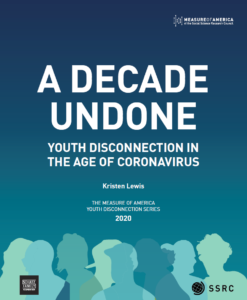
The number of teens and young adults disconnected from both work and school in the United States fell for the eighth year in a row, from a recession-fueled high of 14.7 percent in 2010 to 11.2 percent in 2018. The Covid-19 pandemic will cause youth disconnection rates to spike dramatically. We estimate that the number of disconnected youth will easily top six million and could swell to almost one-quarter of all young people. With students physically disconnected from schools and unemployment the highest it’s been since the Great Depression, young people with the fewest resources will be left even further behind their peers and face the highest barriers to reconnection. While it is clear that young people of all stripes will suffer, low-income people of color will be the hardest hit.
Despite overall improvements in the youth disconnection rate over the last decade, the gaps between racial and ethnic groups
persisted and will be exacerbated by Covid-19. In addition, striking disparities between different geographies within the US remained. Even in economic boom times, vulnerable young people needed far more support, and in the face of Covid-19, their needs have grown.
A Decade Undone: Youth Disconnection in the Age of Coronavirus, written in the months before the pandemic, presents youth disconnection rates for the United States as a whole as well as by gender, race and ethnicity, region, state, metro area, county, and congressional district. For the first time, we also present disconnection rates for each of the country’s roughly 2,400 public use microdata areas (PUMAs), a Census Bureau-defined geography of at least 100,000 people. Using data by PUMA, we introduce a new community typology that highlights the distinct characteristics of the country’s urban, suburban, and rural areas and explores how they affect youth disconnection rates. These pre-coronavirus numbers create a map of vulnerability; they highlight where disconnection rates were already highest and therefore where the situation today is most precarious.
Because this is an election year, A Decade Undone also delves into the relationship between political participation and youth disconnection with a state-level analysis of voter turnout and disconnection rates.
KEY FINDINGS
- Nationally: The 2018 youth disconnection rate is 11.2 percent, or one in nine young people, down from 11.5 percent in 2017. The country’s disconnected youth are nearly twice as likely to live in poverty, more than three times as likely to have a disability of some kind, nine times as likely to have dropped out of high school, and more than twenty times as likely to be living in institutionalized group quarters as their connected counterparts. Disconnected young women are over four times as likely to be mothers as their connected peers.
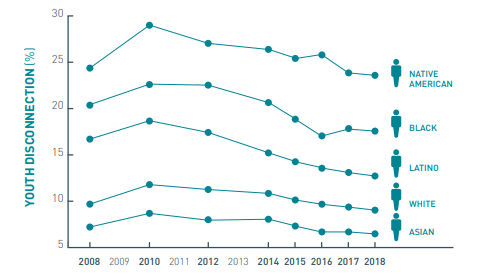
- Race and ethnicity: Native American youth have a disconnection rate of 23.4 percent, the highest of the United States’ five major racial and ethnic groups. Black teens and young adults have the second-highest disconnection rate, 17.4 percent, followed by Latino (12.8 percent), white (9.2 percent), and Asian (6.2 percent) young people.
- Gender: Girls and young women are less likely to be disconnected than boys and young men, 10.8 percent versus 11.5 percent. But the gender gap varies by race and ethnicity. For Latino and Native American youth, young women have slightly higher disconnection rates, whereas for black and white youth, young men do. (Asian men and women’s rates are not significantly different.) Black young people have the largest gender gap of any racial or ethnic group—14.8 percent for black girls and young women, compared to 19.9 percent for their male counterparts. Native American teen girls and young women have the highest disconnection rate of any race/gender combination, 24.8 percent.
- Public use microdata areas (PUMAs): The ten best-performing PUMAs can all be found in affluent sections of large cities or in well-to-do suburbs of major metro areas, and all have youth disconnection rates below 3 percent. The ten PUMAs facing the greatest challenges have youth disconnection rates that range from 29.8 percent to 36.1 percent. Two types of communities are found in this group: low-income, majority-minority neighborhoods in large metro areas, and isolated rural areas characterized by long-term, deep poverty. PUMAs are areas defined by the US Census Bureau; they have populations of at least 100,000 people. To create these geographies, urban counties are split into many PUMAs (Los Angeles has 69, for example) and sparsely populated rural counties are joined together. The result is places with similarly-sized population groups that allow for apples-to-apples comparisons.
- Community Types: A group of PUMAs termed “rural opportunity deserts” in our typology has the highest disconnection rates, with an average of 25.5 percent. Contrary to the typical portrayal of rural areas as overwhelmingly white, 20.3 percent of youth in the country’s most disadvantaged rural areas are black, 24.4 percent are Latino, and 6.4 percent are Native American.
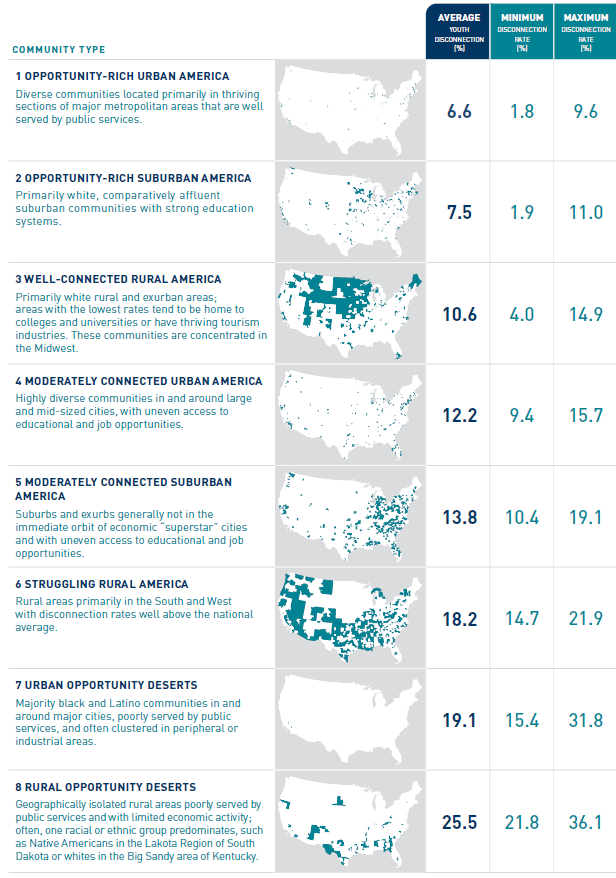
- States: North Dakota has the lowest youth disconnection rate of any state (5.4 percent) and Alaska has the highest (18.1 percent). Alaska experienced the largest increase in the share of disconnected young people between 2017 and 2018, 28.0 percent. The largest drop in disconnection was achieved by Utah, from 9.6 percent in 2017 to 7.3 percent in 2018, a decrease of 24.9 percent. The lowest state-level disconnection rate for young black men (Massachusetts, 11.1 percent) is still well above that same state’s rate for young white men (6.0 percent).
- Metro areas: Provo-Orem, Utah (6.1 percent), boasts the lowest disconnection rate of any metro area in the country. The highest rate of disconnection can be found in Bakersfield, California (20.8 percent).
- Counties: Rural counties have by far the highest average rate of youth disconnection, 18.1 percent; suburban counties have the lowest, 10.4 percent. County youth disconnection rates have the greatest range of any unit of geography. Iowa’s Story County, a small city, has the lowest rate of youth disconnection in the country (1.6 percent), while Georgia’s Hancock County has the highest rate in the country (80.7 percent), a 79.1-percentage-point difference.
- Congessional Districts: Massachusetts District 5, which includes suburbs north and west of Boston, has the lowest rate (4.4 percent). West Virginia District 3, which includes the southern cities of Huntington, Princeton, Bluefield, and Buckley, is home to the highest youth disconnection rate, 21.9 percent.
- Political Participation: Youth voter turnout increased between 2014 and 2018 in nearly every state, but the states where more youth are working or in school saw the greatest increase in youth civic engagement. On average, for every 1 percentage point lower a state’s disconnection rate is than another’s, its voter turnout rate increase is 1.3 percentage points higher.
RECOMMENDATIONS
Covid-19 has likely erased ten years’ progress in reducing the national youth disconnection rate in a matter of months. It is difficult, at the height of the pandemic, to make recommendations for a future whose landscape we cannot yet divine. Nonetheless, a few things are clear. The 2020 youth disconnection rate will spike, and disconnected youth and their families will be hit the hardest. Read about challenges and recommendations here.
“Mobilizing knowledge for the public good is the core mission of the SSRC,” said Alondra Nelson, president of the Social Science Research Council. “Now more than ever, as we struggle to understand and address the interlocking crises of persistent disadvantage, the disproportionate impact of Covid-19 on people of color, and our tragic history of police brutality against Black people, research like this that illuminates the nature and extent of inequalities among America’s teens and young adults is critical.”
…
“Measure of America’s reports on youth disconnection are indispensable reading for anyone who wants to understand this key public health issue. Their latest release, “A Decade Undone: Youth Disconnection in the Age of Coronavirus,” contains several excellent new features. These include youth disconnection calculations at a fine-grained level based on approximately 2,400 public use microdata areas (PUMAs), a novel way of characterizing urban, suburban, and rural communities, and associations of youth disconnection with youth voter turnout. The report frames findings from analyses of 2018 data in the context of the 2020 global pandemic and its devastating impacts on youth connections to education and employment. I know I’ll be turning to this critical resource again and again.”
…
“Even before the COVID-19 crisis, disconnected youth were at a higher risk of poor health and economic outcomes as compared to their peers. Unfortunately, the pandemic has further widened the divide for an already vulnerable community. Now more than ever, measuring and tracking disconnection rates is critical to informing our work to continue to keep young people at the forefront of opportunity.”
ACKNOWLEDGEMENTS
This report is made possible by The Schultz Family Foundation. The Schultz Family Foundation partners with like-minded businesses and community-based organizations to build a new approach to youth development and economic mobility. Through our Opportunity Youth initiative, we forge unique partnerships and invest in clear pathways to employment. By focusing on both traditional and innovative programs such as mentorship, access to housing, job readiness and community connections, the Foundation helps close the opportunity gap for these young people so they, in turn, can build communities and families that prosper into the next generation.
Making the Connection
Making the Connection: Transportation and Youth Disconnection
To see the most recent data, check out our interactive tool on youth disconnection.
LAUNCHED APRIL 25, 2019
FULL REPORT | INTERACTIVE TOOL | MEDIA RELEASE
Read the companion congressional district brief.
Since its peak in the aftermath of the Great Recession, the number of teens and young adults disconnected from both work and school in the United States fell for the seventh year in a row. The 2017 disconnection rate is 11.5 percent, a significant drop from the post-recession high of 14.7 percent in 2010. But a look into the latest data also shows some causes for concern. First, the decrease in the national disconnection rate between 2016 (11.7 percent) and 2017 (11.5 percent) was negligible. Second, for some groups, progress has halted or even reversed. The youth disconnection rate for black teens and young adults increased between 2016 and 2017. And despite years of decline in the country’s overall
disconnection rate, disparities between racial and ethnic groups persist. These findings indicate we cannot rely on economic growth alone to solve the problem of youth disconnection in America—societal factors such as poverty, discrimination, and residential segregation also play significant roles.
Making the Connection: Transportation and Youth Disconnection presents the latest available data on youth disconnection for the United States as a whole as well as disconnection rates by gender, race and ethnicity, region, state, and metro area. Determining who remains disconnected, and why, is vital to identifying interventions that will sustain or accelerate the positive trend we have observed over the past seven years. Because reducing youth disconnection will require an understanding of the structural factors driving it, the report also examines a key factor preventing young people from staying in school and the workforce: disparities in access to reliable and affordable transportation. Future reports will address additional structural barriers fueling disconnection.
KEY FINDINGS
- Nationally: The youth disconnection rate for the United States overall was 11.5 percent in 2017—down from 11.7 percent the previous year. This represents a total of about 4.5 million young people, or about one in nine.
- Disability: Disconnected young people are more than three times as likely to have a disability of some kind than connected young people—16.6 percent as compared to 5.0 percent. White male disconnected youth have the highest disability rate, 23.0 percent, but in general face fewer structural barriers to school persistence and employment than other groups.

- Gender: Boys and young men are slightly more likely to be disconnected than girls and young women, 11.9 percent as compared to 11.1 percent. But this ranking varies by race; among Asian, Latino, and Native American youth, young women have a slightly higher disconnection rate, whereas for black and white youth, young men do. The size of the gender gap is largest for black young people.
- Race and ethnicity: Of the country’s five major racial and ethnic groups, Asian American youth have the lowest disconnection rate, 6.6 percent, unchanged from their 2016 rate. White youth have the second-lowest rate (9.4 percent), followed by Latino (13.2 percent), black (17.9 percent), and Native American youth (23.9 percent). Latino youth saw the greatest improvement in their disconnection rate between 2016 to 2017, while black teens and young adults are the only group whose disconnection rate increased. Disconnection rates also vary by Asian and Latino subgroup.
- Regions: Disconnection continues to be a particular challenge in the South. The East South Central area, which includes Kentucky, Tennessee, Mississippi, and Alabama, has the highest disconnection rate overall, 14.2 percent. New England has the lowest rate, 8.26 percent.
- States: Minnesota has the lowest rate of youth disconnection (6.2 percent), followed by Iowa (7.0 percent) and Massachusetts (7.1 percent). West Virginia has the highest rate, 17.0 percent, followed by New Mexico (16.5 percent) and Mississippi (16.4 percent). Idaho experienced the largest increase in the share of disconnected young people between 2016 and 2017, nearly 25 percent. The state’s 2017 rate of 13.6 percent is almost as high as its 2014 peak of 14.0 percent. Alaska saw the largest drop in its disconnection rate, a decrease of 27 percent.
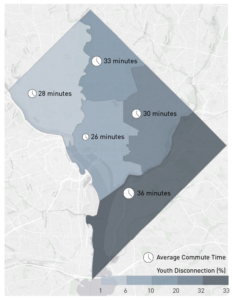
- Metro areas: Metro area youth disconnection rates range from a low of 5.6 percent in greater Grand Rapids, Michigan, to a high of 18.0 percent in the Memphis metro area. Metro area disconnection rates vary by gender as well as race and ethnicity. The metro area with the largest racial or ethnic gap is Louisville, KY-IN, where the black-white gap is 17.6 percentage points.
- Transportation: An examination of disconnection rates and commute times in two major cities, Washington, DC, and Chicago, reveals a link between transportation and youth disconnection. Average commute time and the youth disconnection rate are strongly correlated across DC neighborhoods. The correlation between the youth disconnection rate and the percentage of workers with very long commutes is also strong. In Chicago, the five areas with the highest youth disconnection rates, all above 20 percent, also have the highest rates of workers commuting an hour or more each way.
RECOMMENDATIONS
Through our research and engagement with stakeholders over the years, we have learned in greater detail about the challenges related to youth disconnection, as well as what works in addressing them. Though they overlap, these challenges and related recommendations can be organized into four very general buckets: confronting historical and intergenerational disadvantage, especially racism; supporting vulnerable youth; keeping youth connected; and reengaging disconnected youth. Read about challenges and recommendations here.
“Since its first report on the topic in 2012, Measure of America has provided rigorous and informative analysis of the experiences of this significant youth population.This report exemplifies the SSRC’s commitment to research that advances the public good and informs public debate.”
—Alondra Nelson, President of the Social Science Research Council
“At the Schultz Family Foundation, we believe every young person has the potential to succeed, and we’re committed to using research and data to inform both our efforts and the larger field of practice. Today’s report from Measure of America reinforces the importance in investing in this next generation of young people.”
—Daniel Pitasky, Executive Director of the Schultz Family Foundation
“Young people are the future of America. This could not be any clearer based upon the Measure of America work and report. Bias against any racial, ethnic or regional group that impedes the growth and development of this crucial segment of America’s population is not only cruel and unfair; it threatens the future social and economic prosperity and well-being of the nation. We must do all we can to make sure that all of America’s youth stay connected and committed to the future development and growth of America. It is not only the right thing to do, it is the smart course of action for our nation’s leaders.”
—James S. Jackson, Daniel Katz Distinguished University Professor of Psychology at the University of Michigan
Promising Gains, Persistent Gaps
To see the most recent data, check out our interactive tool on youth disconnection.
LAUNCHED MARCH 8, 2017
FULL REPORT | INTERACTIVE TOOL | MEDIA RELEASE
Read the congressional districts brief here.
Check out Measure of America and LeadersUp’s white paper on youth disconnection in Chicago.
Since Measure of America first wrote about youth disconnection half a decade ago, public awareness of both the plight and the promise of young people who are not in either school or the workforce has grown by leaps and bounds. Support for alternative school-to-work pathways like apprenticeships and career-technical education have seen a resurgence, the business-led 100,000 Opportunities Initiative met its goal to hire one hundred thousand disconnected youth well ahead of schedule, and at the time of writing, the Opening Doors for Youth Act of 2016 was introduced in Congress to make available significant federal investment to reconnect young people to school and employment.
Thanks to a greatly improved economy and efforts like those described above, the country has made real progress in tackling this important issue; this is good news we should all celebrate. But challenges remain: 4.9 million young women and men are still disconnected from the educational and employment opportunities required for rewarding, productive lives. If all disconnected youth lived together in a single state, that state would have roughly the population of South Carolina or Colorado. This report takes a look at who comprises this remaining group, what particular challenges they face, and what strategies have been shown to work.
Key findings include:
• Overall. In 2015, 4.9 million young adults between the ages of 16 and 24 were disconnected—12.3 percent of American youth, about one in eight. This is a significant drop from the post-recession high of 14.7 percent, over 5.8 million youth, in 2010.
• Rural-urban divide. This research shows that rural counties as a whole are faring considerably worse than more populous counties in terms of youth disconnection. In completely rural counties, the youth disconnection rate is 20.3 percent, much higher than the rate for counties in urban centers (14.2 percent) or for suburban counties (12.3 percent). Rural counties in the South have a particularly high rate: 24.0 percent—double the national rate.
• Race and ethnicity. There is astonishing variation in disconnection rates by race and ethnicity, ranging from nearly one in fourteen Asian American youth to more than one in four Native American young people. The Asian American youth disconnection rate is 7.2 percent; the white rate is 10.1 percent; the Latino rate is 14.3 percent; the black rate is 18.9 percent; and the Native American rate is 25.4 percent. Though the rate varies among Asian subgroups, most are performing well on this indicator; only Hmong Americans have a rate of youth disconnection that surpasses the US average.
• Women and men. Nationally, girls and young women are slightly less likely to be disconnected than boys and young men, 12.0 percent vs. 12.5 percent, a small but statistically significant difference. The difference in youth disconnection rates between genders plays out differently for each race or ethnic group.
• States. Young people are disconnected at rates that range from under 8 percent in some states (New Hampshire, Nebraska, North Dakota, Vermont, Minnesota, and Iowa) to over twice that in others, with New Mexico (17.4 percent), West Virginia (17.0 percent), and Mississippi (16.7 percent) facing the greatest challenges.
• Black-white gaps. Measure of America calculated the disconnection rate for blacks, Latinos, and whites at the state level when data allowed. The black-white disparity is so stark that even in states where white youth are faring the worst, they are still doing better than US blacks on average, and even in states where blacks are faring the best, they are still not doing as well as US whites on average.
• Top and bottom metro areas. Among the country’s ninety-eight most populous metro areas, greater Albany, NY (6.5 percent), Grand Rapids, MI (6.8 percent), and Omaha, NE-IA (7.1 percent) had the lowest youth disconnection rates. The Bakersfield, CA (18.7 percent), McAllen, TX (19.7 percent), and Augusta, GA-SC (21.0 percent) metro areas had the highest rates.
• Congressional districts. Youth disconnection rates vary enormously by congressional district—from an impressively low rate of 4.4 percent in Wisconsin District 2, the mostly urban Madison area, to an alarmingly high rate of 23.1 percent—or nearly one in every four young people—in Kentucky District 5 in rural Appalachia. On average, a gap of 7.4 percentage points separates the best and worst districts within a state.
• Impact of poverty. For young people of all races, the probability of disconnection falls as household incomes rise. White youth in affluent households are less likely to be disconnected than white youth in poor households, and the same is true for the other racial and ethnic groups; however, blacks, Latinos, and Native Americans are more likely to be disconnected than whites and Asians given the same income level. In fact, the rate of youth disconnection for Asian Americans in households with almost no income is the same as that for black youth in households with incomes close to five times the federal poverty line. Native American youth living in households with incomes at five times the poverty line face roughly the same probablity of disconnection as white youth living in households with incomes well below the poverty line.
• Biggest improvements. Between 2010 and 2015, Washington, DC made the greatest progress, with a 43.9 percent reduction in the rate of youth disconnection. New Hampshire had the second-largest drop, nearly 32 percent, and now has the lowest rate of any state.
__________________________________________________________________________
For media and all other inquiries, contact us at: contact@measureofamerica.org | (718) 517-3720.
Zeroing In on Place and Race
To see the most recent data, check out our interactive tool on youth disconnection.
LAUNCHED JUNE 10, 2015
FULL REPORT | INTERACTIVE TOOL | MEDIA RELEASE
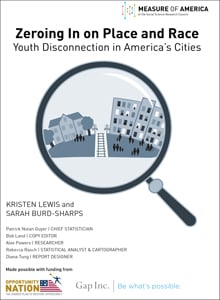 Zeroing In on Place and Race is an in-depth look at how disconnected youth are faring in America’s cities, with data included on disconnected youth by state, congressional district, county, gender, and by race and ethnicity. Disconnected youth are teenagers and young adults between the ages of 16 and 24 who are neither working nor in school. There are 5,527,000 disconnected youth in America today, or one in seven young adults (13.8 percent)—about as many people as live in Minnesota. The national disconnected youth population is larger than the populations of thirty US states.
Zeroing In on Place and Race is an in-depth look at how disconnected youth are faring in America’s cities, with data included on disconnected youth by state, congressional district, county, gender, and by race and ethnicity. Disconnected youth are teenagers and young adults between the ages of 16 and 24 who are neither working nor in school. There are 5,527,000 disconnected youth in America today, or one in seven young adults (13.8 percent)—about as many people as live in Minnesota. The national disconnected youth population is larger than the populations of thirty US states.
KEY FINDINGS
- The rate of youth disconnection has fallen since the Great Recession. Roughly 280,000 fewer young people are disconnected today than in 2010, the peak year for youth disconnection during the last decade. Beneath the national rate of 13.8 percent, however, lies staggering variation.
- Of the ninety-eight major metro areas included in this report—home to two in three Americans— disconnection rates range from under 8 percent in the Omaha, Nebraska, and Bridgeport, Connecticut, metro areas to over 20 percent in greater Lakeland, Florida; Bakersfield, California; and Memphis, Tennessee.
- At the national level, youth disconnection rates for blacks (21.6 percent), Native Americans (27.8 percent), and Latinos (16.3 percent) are markedly higher than rates for Asian Americans (7.9 percent) or whites (11.3 percent). In nine metro areas, at least one in four black youth are disconnected. In ten metro areas, at least one in five Latino youth are disconnected.
- The negative effects of youth disconnection ricochet across the economy, the social sector, the criminal justice system, and the political landscape, affecting all of us. Our analysis of a very small subset of the direct costs of youth disconnection reveals an astonishingly high cost to taxpayers: $26.8 billion in 2013 alone, or nearly the entire amount the federal government spends on science.
- Although national patterns are generally mirrored in metro areas, important variation exists. For instance, a city can simultaneously be among the best for one racial or ethnic group and among the worst for another. The greater Boston metro area, which has a low overall disconnection rate (8.2 percent), is relatively good for white (6.8 percent) and black youth (9.8 percent), but not for Latinos (17.3 percent). In the Chicago metro area, both whites and Latinos are doing better than they are in the country as a whole (7.5 and 13.9 percent, respectively), but blacks are doing much worse (24.5 percent).
- New research for this report shows that racial segregation has dramatic but very different consequences for young people depending on their race. Our research shows that in highly segregated metro areas, black youth tend to have higher-than-average rates of disconnection, whereas white youth tend to have lower-than average rates of disconnection. In other words, residential segregation by race disproportionately harms black teenagers and young adults.
Connecting Youth and Strengthening Communities
RELEASED SEPTEMBER 29, 2014
FULL REPORT | INTERACTIVE TOOL
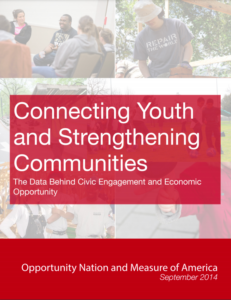 Measure of America has developed a new analysis for Opportunity Nation that explores the relationship between civic engagement and opportunity. Supported by the Citi Foundation, the report, “Connecting Youth and Strengthening Communities: The Data Behind Civic Engagement and Economic Opportunity,” provides data and analysis that builds on previous studies that found associations between civic engagement and economic opportunity.
Measure of America has developed a new analysis for Opportunity Nation that explores the relationship between civic engagement and opportunity. Supported by the Citi Foundation, the report, “Connecting Youth and Strengthening Communities: The Data Behind Civic Engagement and Economic Opportunity,” provides data and analysis that builds on previous studies that found associations between civic engagement and economic opportunity.
According to Kristen Lewis, Co-director of Measure of America, “Today, 5.8 million young people—about one in seven Americans between the ages of 16 and 24—are neither working nor in school. Finding ways to connect them to mainstream opportunities is vital to their futures. If we do nothing, the cost to society as a whole will be great.”
The report found that civic engagement may help youth, particularly low-income teens and young adults ages 16-24, build social capital and skills that can help them find meaningful education and career pathways. Further, two forms of civic engagement in particular—volunteering and membership in a civic or service organization—are significant predictors of economic opportunity across states.
Other key findings:
Youth who volunteer are considerably less likely than their non-volunteering peers to be disconnected from work and school. In fact, the likelihood that a young person is disconnected drops nearly in half if he or she volunteers.
 Civic engagement—specifically volunteering and participation in a civic or service organization—is a significant predictor of economic opportunity across states. Volunteerism has an inverse relationship with income inequality. In places with higher rates of volunteerism, income inequality tends to be lower.
Civic engagement—specifically volunteering and participation in a civic or service organization—is a significant predictor of economic opportunity across states. Volunteerism has an inverse relationship with income inequality. In places with higher rates of volunteerism, income inequality tends to be lower.
Intuitively, we know that joining an organization, attending a public meeting or donating time or money to a charitable cause can all contribute to the social good. But there is a growing body of research that highlights additional benefits for individuals and society.
…
For media and all other inquiries, contact us at: contact@measureofamerica.org.
HALVE THE GAP BY 2030: Youth Disconnection in America’s Cities
To see the most recent data, check out our interactive tool on youth disconnection.
LAUNCHED OCTOBER 24, 2013
FULL REPORT | INTERACTIVE TOOL | MEDIA RELEASE
Once again, the back-to-school season has come and gone. High school and college students have settled into new routines, and recent grads have moved on to new roles. But an astounding 5.8 million teens and young adults between the ages of 16 and 24 are neither working nor in school. As their peers lay the foundation for a productive and meaningful adulthood, these disconnected youth find themselves unmoored from the structures that confer knowledge, skills, identity, and purpose.
Just over a year ago, Measure of America published its initial research on the epidemic of youth disconnection called One in Seven. This report updates last year’s findings with the latest numbers and, to better map the landscape of youth disconnection, also presents the data by neighborhood cluster for each of the twenty-five most populous US metro areas.
Key findings include the following:
- Boston (9.2 percent), Minneapolis (9.5 percent), and Washington, DC (11.3 percent) have the lowest rates of youth disconnection among the twenty-five most populous metro areas.
- Charlotte (17.3 percent), Detroit (17.4 percent), and Riverside–San Bernardino (18.8 percent) are home to the greatest share of disconnected young people.
- The greatest disparities are found not between but within our nation’s big cities. In Chicago, New York, and Detroit, gaps of approximately 30 percentage points separate the most- and least-connected neighborhood clusters.
- A chasm separates different racial and ethnic groups. In Pittsburgh and St. Louis, one in every four African American young people is disconnected, compared to one in every ten white youth. Nationwide, African Americans are roughly three times as likely as Asian Americans and twice as likely as whites to be disconnected in their teens and early twenties.
In addition to painting a picture of youth disconnection in America today, in this report we imagine, in very specific terms, a different, better tomorrow. We lay out an ambitious but attainable goal: to halve the gaps between the most- and least-connected neighborhoods and between racial groups in half by 2030. Our research has convinced us that, through the collective efforts of educational institutions, social service delivery organizations, the justice system, the private and nonprofit sectors, and others, this objective is within reach. By coalescing around a shared goal, we can galvanize greater attention to the problem, mobilize more resources, and put in place a system of accountability for tracking our progress annually.
What would it mean in practice to halve the gap? In Philadelphia, the African American youth disconnection rate is 25.2 percent, and the white rate is 8.9 percent, a gap of 16.3 percentage points; halving the racial gap would mean that no more than 8.15 percentage points would separate blacks and whites by 2030. In terms of Philly neighborhoods, the highest youth disconnection rate is 30 percent, the lowest, 3.2 percent, a gap of 26.8 percentage points; halving the neighborhood gap would mean no more than 13.4 percentage points would separate any two neighborhoods by 2030.
We firmly believe that setting measurable, time-bound targets for reducing youth disconnection is key to moving the needle on this critical issue. Knowing where you want to go is fundamental to getting there.
__________________________________________________________________________
For media and all other inquiries, contact us at: contact@measureofamerica.org.
One in Seven
One in Seven: Ranking Youth Disconnection in the 25 Largest Metro Areas
To see the most recent data, check out our interactive tool on youth disconnection.
LAUNCHED SEPTEMBER 13, 2012
FULL REPORT | INTERACTIVE TOOL | MEDIA RELEASE
 What’s new in this report?
What’s new in this report?
An astonishing one in every seven Americans ages 16 to 24 is neither working nor in school—5.8 million young people in all. As their peers lay the foundation for a productive, fulfilling adulthood, these disconnected youth find themselves adrift at society’s margins, unmoored from the structures that confer knowledge, skills, identity, and purpose.
The cost is high for affected individuals—and for society as a whole. Lack of attachment to the anchor institutions of school or work at this stage of life can leave scars that last a lifetime, affecting everything from earnings and financial independence to physical and mental health and even marital prospects. And last year alone, youth disconnection cost taxpayers $93.7 billion in government support and lost tax revenue.
This brief ranks the country’s 25 largest metropolitan areas as well as the nation’s largest racial and ethnic groups in terms of youth disconnection. Key findings include the following:
- Big gaps separate major metro areas; in bottom-ranked Phoenix, 19 percent of young people are disconnected from the worlds of work and school, whereas in Boston, which tops the chart, only about 9 percent are.
- African American young people have the highest rate of youth disconnection, 22.5 percent nationally. In Pittsburgh, Seattle, Detroit, and Phoenix, more than one in four African American young people are disconnected.
- Young men are slightly more likely to be disconnected than young women, a reversal of the situation found in decades past. The situation varies by race and ethnicity, however. The gender gap is largest among African Americans; nationally, 26 percent of African American male youth are disconnected, compared to 19 percent of their female counterparts.
- Youth disconnection mirrors adult disconnection: household poverty rates and the employment and educational status of adults in a community are strongly associated with youth disconnection.
- Where a young person lives is highly predictive of his or her likelihood of disconnection. The findings break down youth disconnection by neighborhoods within cities. The disparities between wealthy and poor communities are striking. For example, in New York, disconnection rates range from 3.7 percent in parts of Long Island to 35.6 percent in parts of the South Bronx.
The report concludes with a set of recommendations for preventing youth disconnection, including moving beyond the “college-for-all” mantra to provide meaningful support and guidance both to young people aiming for a four-year bachelor’s degree and to those whose interests and career aspirations would be better served by relevant, high-quality career and technical education certificates and associate’s degrees.
__________________________________________________________________________
For media and all other inquiries, contact us at: contact@measureofamerica.org.
